SXL3136 - Bangor University: Analysis of Copyright Directive
VerifiedAdded on 2023/04/24
|13
|5119
|484
Essay
AI Summary
This essay critically examines Article 11 and Article 13 of the draft Directive on Copyright in the Digital Single Market, published by the European Commission on September 14, 2016. It provides a background on the development of digital technologies and the need for copyright reform within the EU. The analysis covers the implications of Article 11, which focuses on the rights of press publications and the use of journalistic content by online platforms, and Article 13, which addresses the use of copyrighted material by online content sharing service providers. The essay also considers amendments made to both articles, highlighting their potential impact on internet users, content creators, and digital media platforms. Desklib offers a platform for students to access this and other solved assignments for academic support.
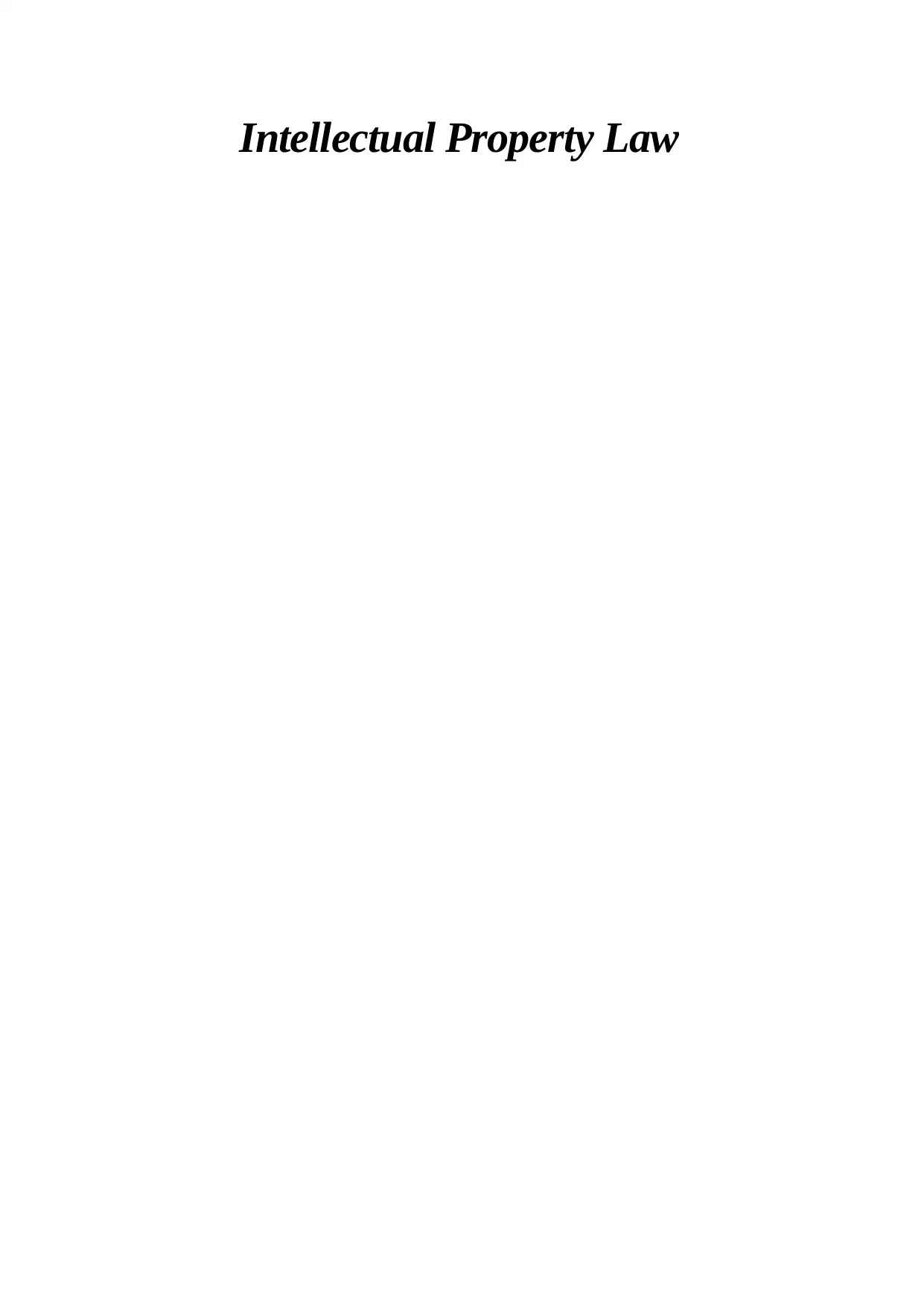
Intellectual Property Law
Paraphrase This Document
Need a fresh take? Get an instant paraphrase of this document with our AI Paraphraser
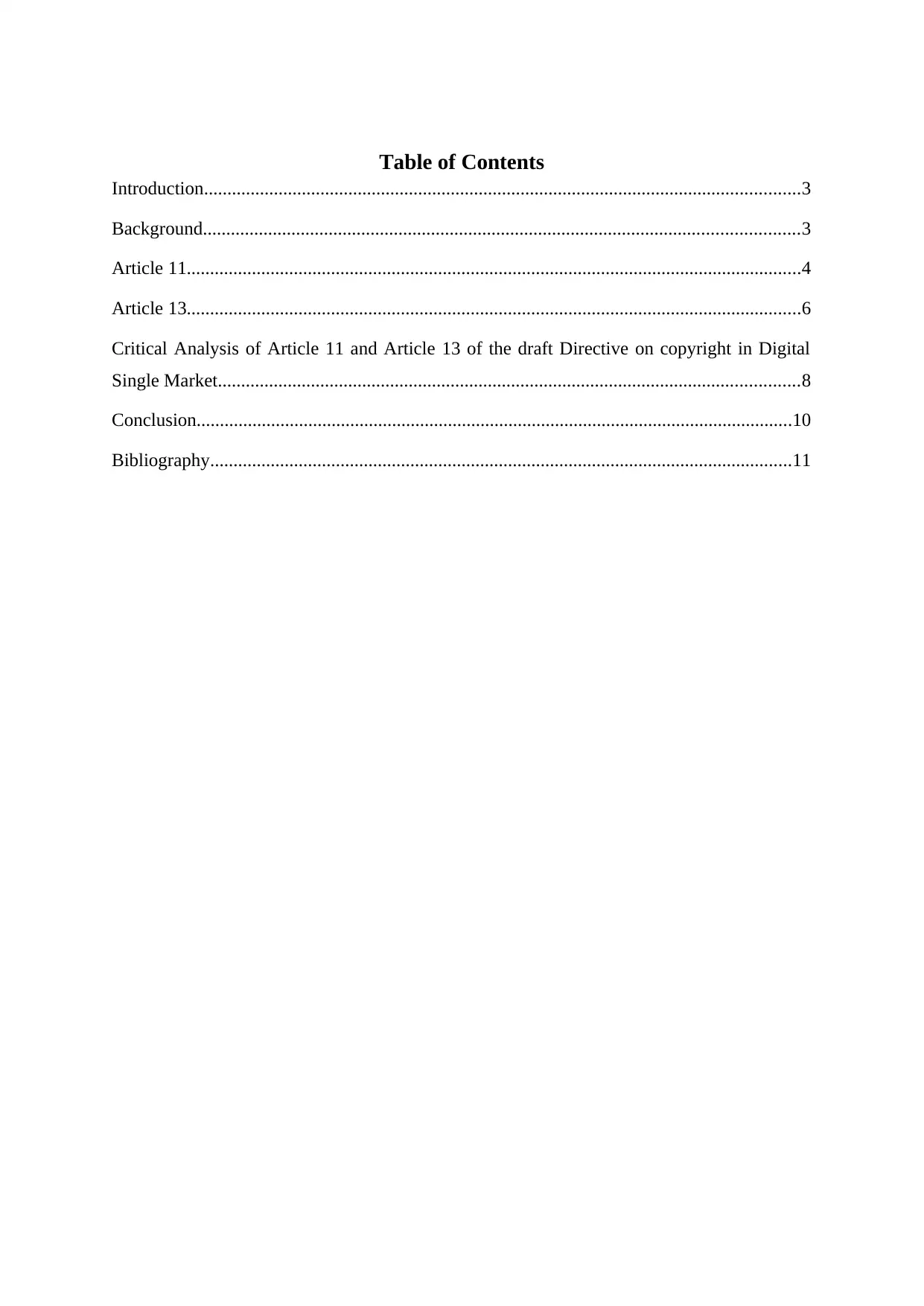
Table of Contents
Introduction................................................................................................................................3
Background................................................................................................................................3
Article 11....................................................................................................................................4
Article 13....................................................................................................................................6
Critical Analysis of Article 11 and Article 13 of the draft Directive on copyright in Digital
Single Market.............................................................................................................................8
Conclusion................................................................................................................................10
Bibliography.............................................................................................................................11
Introduction................................................................................................................................3
Background................................................................................................................................3
Article 11....................................................................................................................................4
Article 13....................................................................................................................................6
Critical Analysis of Article 11 and Article 13 of the draft Directive on copyright in Digital
Single Market.............................................................................................................................8
Conclusion................................................................................................................................10
Bibliography.............................................................................................................................11
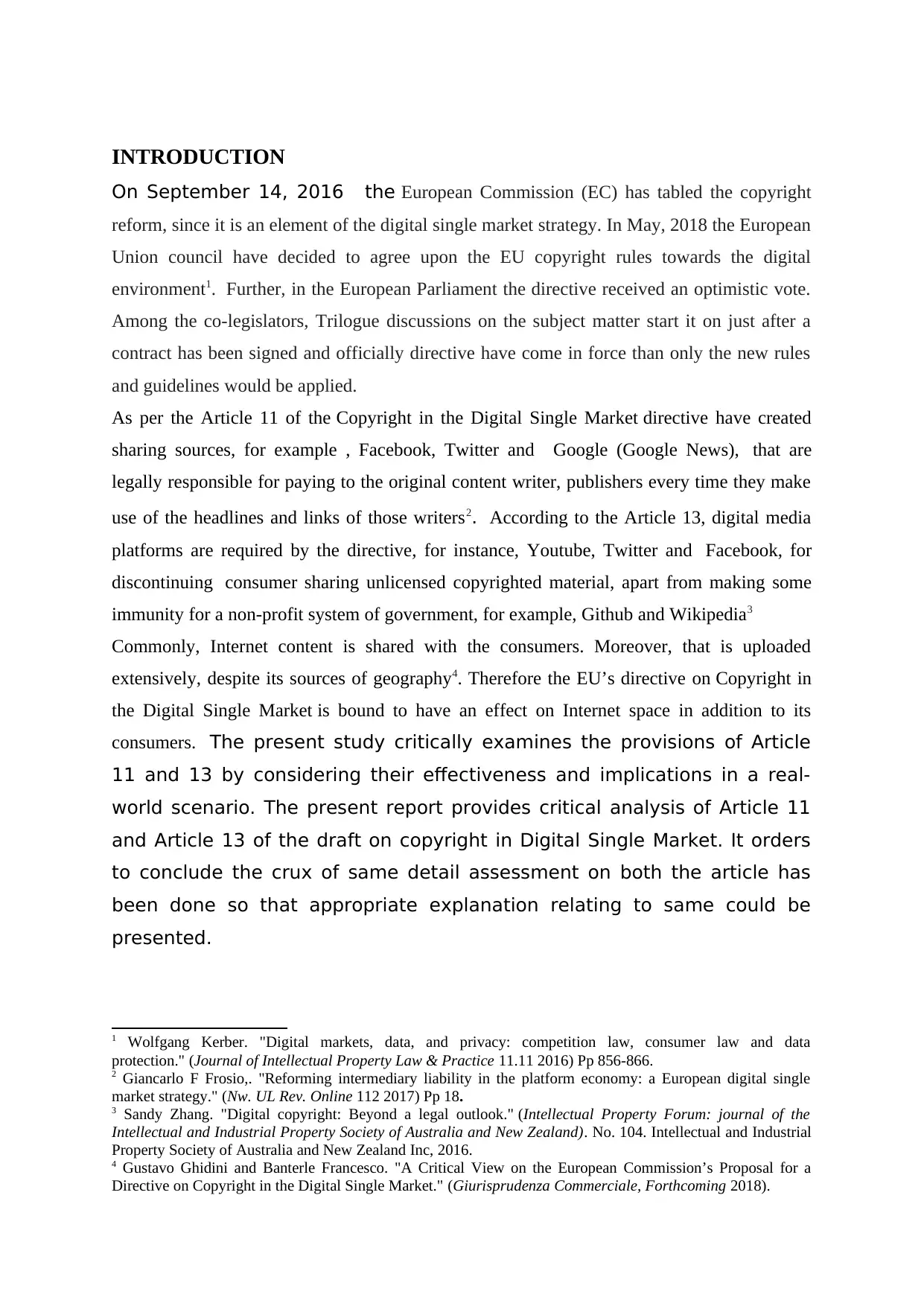
INTRODUCTION
On September 14, 2016 the European Commission (EC) has tabled the copyright
reform, since it is an element of the digital single market strategy. In May, 2018 the European
Union council have decided to agree upon the EU copyright rules towards the digital
environment1. Further, in the European Parliament the directive received an optimistic vote.
Among the co-legislators, Trilogue discussions on the subject matter start it on just after a
contract has been signed and officially directive have come in force than only the new rules
and guidelines would be applied.
As per the Article 11 of the Copyright in the Digital Single Market directive have created
sharing sources, for example , Facebook, Twitter and Google (Google News), that are
legally responsible for paying to the original content writer, publishers every time they make
use of the headlines and links of those writers2. According to the Article 13, digital media
platforms are required by the directive, for instance, Youtube, Twitter and Facebook, for
discontinuing consumer sharing unlicensed copyrighted material, apart from making some
immunity for a non-profit system of government, for example, Github and Wikipedia3
Commonly, Internet content is shared with the consumers. Moreover, that is uploaded
extensively, despite its sources of geography4. Therefore the EU’s directive on Copyright in
the Digital Single Market is bound to have an effect on Internet space in addition to its
consumers. The present study critically examines the provisions of Article
11 and 13 by considering their effectiveness and implications in a real-
world scenario. The present report provides critical analysis of Article 11
and Article 13 of the draft on copyright in Digital Single Market. It orders
to conclude the crux of same detail assessment on both the article has
been done so that appropriate explanation relating to same could be
presented.
1 Wolfgang Kerber. "Digital markets, data, and privacy: competition law, consumer law and data
protection." (Journal of Intellectual Property Law & Practice 11.11 2016) Pp 856-866.
2 Giancarlo F Frosio,. "Reforming intermediary liability in the platform economy: a European digital single
market strategy." (Nw. UL Rev. Online 112 2017) Pp 18.
3 Sandy Zhang. "Digital copyright: Beyond a legal outlook." (Intellectual Property Forum: journal of the
Intellectual and Industrial Property Society of Australia and New Zealand). No. 104. Intellectual and Industrial
Property Society of Australia and New Zealand Inc, 2016.
4 Gustavo Ghidini and Banterle Francesco. "A Critical View on the European Commission’s Proposal for a
Directive on Copyright in the Digital Single Market." (Giurisprudenza Commerciale, Forthcoming 2018).
On September 14, 2016 the European Commission (EC) has tabled the copyright
reform, since it is an element of the digital single market strategy. In May, 2018 the European
Union council have decided to agree upon the EU copyright rules towards the digital
environment1. Further, in the European Parliament the directive received an optimistic vote.
Among the co-legislators, Trilogue discussions on the subject matter start it on just after a
contract has been signed and officially directive have come in force than only the new rules
and guidelines would be applied.
As per the Article 11 of the Copyright in the Digital Single Market directive have created
sharing sources, for example , Facebook, Twitter and Google (Google News), that are
legally responsible for paying to the original content writer, publishers every time they make
use of the headlines and links of those writers2. According to the Article 13, digital media
platforms are required by the directive, for instance, Youtube, Twitter and Facebook, for
discontinuing consumer sharing unlicensed copyrighted material, apart from making some
immunity for a non-profit system of government, for example, Github and Wikipedia3
Commonly, Internet content is shared with the consumers. Moreover, that is uploaded
extensively, despite its sources of geography4. Therefore the EU’s directive on Copyright in
the Digital Single Market is bound to have an effect on Internet space in addition to its
consumers. The present study critically examines the provisions of Article
11 and 13 by considering their effectiveness and implications in a real-
world scenario. The present report provides critical analysis of Article 11
and Article 13 of the draft on copyright in Digital Single Market. It orders
to conclude the crux of same detail assessment on both the article has
been done so that appropriate explanation relating to same could be
presented.
1 Wolfgang Kerber. "Digital markets, data, and privacy: competition law, consumer law and data
protection." (Journal of Intellectual Property Law & Practice 11.11 2016) Pp 856-866.
2 Giancarlo F Frosio,. "Reforming intermediary liability in the platform economy: a European digital single
market strategy." (Nw. UL Rev. Online 112 2017) Pp 18.
3 Sandy Zhang. "Digital copyright: Beyond a legal outlook." (Intellectual Property Forum: journal of the
Intellectual and Industrial Property Society of Australia and New Zealand). No. 104. Intellectual and Industrial
Property Society of Australia and New Zealand Inc, 2016.
4 Gustavo Ghidini and Banterle Francesco. "A Critical View on the European Commission’s Proposal for a
Directive on Copyright in the Digital Single Market." (Giurisprudenza Commerciale, Forthcoming 2018).
⊘ This is a preview!⊘
Do you want full access?
Subscribe today to unlock all pages.

Trusted by 1+ million students worldwide
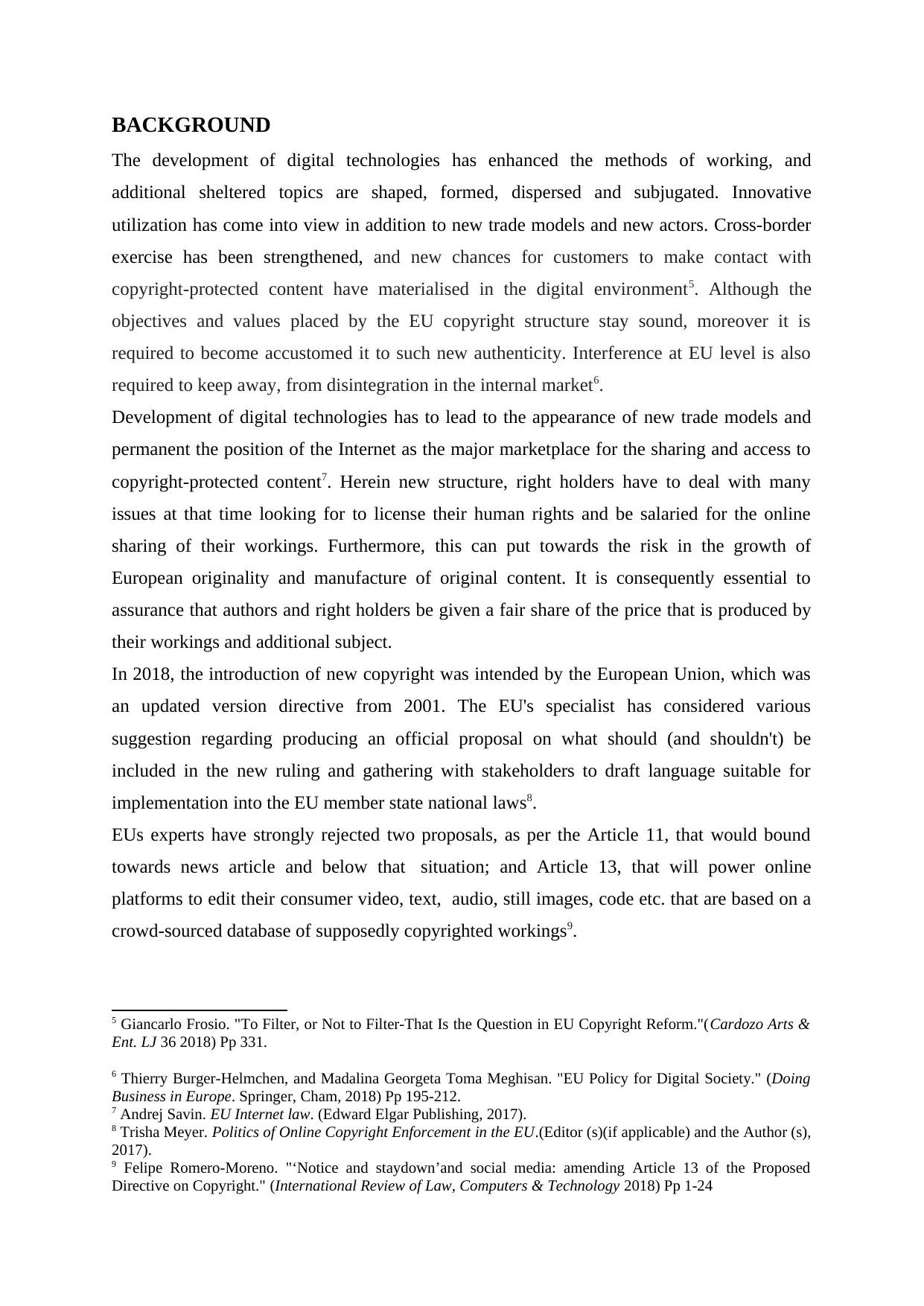
BACKGROUND
The development of digital technologies has enhanced the methods of working, and
additional sheltered topics are shaped, formed, dispersed and subjugated. Innovative
utilization has come into view in addition to new trade models and new actors. Cross-border
exercise has been strengthened, and new chances for customers to make contact with
copyright-protected content have materialised in the digital environment5. Although the
objectives and values placed by the EU copyright structure stay sound, moreover it is
required to become accustomed it to such new authenticity. Interference at EU level is also
required to keep away, from disintegration in the internal market6.
Development of digital technologies has to lead to the appearance of new trade models and
permanent the position of the Internet as the major marketplace for the sharing and access to
copyright-protected content7. Herein new structure, right holders have to deal with many
issues at that time looking for to license their human rights and be salaried for the online
sharing of their workings. Furthermore, this can put towards the risk in the growth of
European originality and manufacture of original content. It is consequently essential to
assurance that authors and right holders be given a fair share of the price that is produced by
their workings and additional subject.
In 2018, the introduction of new copyright was intended by the European Union, which was
an updated version directive from 2001. The EU's specialist has considered various
suggestion regarding producing an official proposal on what should (and shouldn't) be
included in the new ruling and gathering with stakeholders to draft language suitable for
implementation into the EU member state national laws8.
EUs experts have strongly rejected two proposals, as per the Article 11, that would bound
towards news article and below that situation; and Article 13, that will power online
platforms to edit their consumer video, text, audio, still images, code etc. that are based on a
crowd-sourced database of supposedly copyrighted workings9.
5 Giancarlo Frosio. "To Filter, or Not to Filter-That Is the Question in EU Copyright Reform."(Cardozo Arts &
Ent. LJ 36 2018) Pp 331.
6 Thierry Burger-Helmchen, and Madalina Georgeta Toma Meghisan. "EU Policy for Digital Society." (Doing
Business in Europe. Springer, Cham, 2018) Pp 195-212.
7 Andrej Savin. EU Internet law. (Edward Elgar Publishing, 2017).
8 Trisha Meyer. Politics of Online Copyright Enforcement in the EU.(Editor (s)(if applicable) and the Author (s),
2017).
9 Felipe Romero-Moreno. "‘Notice and staydown’and social media: amending Article 13 of the Proposed
Directive on Copyright." (International Review of Law, Computers & Technology 2018) Pp 1-24
The development of digital technologies has enhanced the methods of working, and
additional sheltered topics are shaped, formed, dispersed and subjugated. Innovative
utilization has come into view in addition to new trade models and new actors. Cross-border
exercise has been strengthened, and new chances for customers to make contact with
copyright-protected content have materialised in the digital environment5. Although the
objectives and values placed by the EU copyright structure stay sound, moreover it is
required to become accustomed it to such new authenticity. Interference at EU level is also
required to keep away, from disintegration in the internal market6.
Development of digital technologies has to lead to the appearance of new trade models and
permanent the position of the Internet as the major marketplace for the sharing and access to
copyright-protected content7. Herein new structure, right holders have to deal with many
issues at that time looking for to license their human rights and be salaried for the online
sharing of their workings. Furthermore, this can put towards the risk in the growth of
European originality and manufacture of original content. It is consequently essential to
assurance that authors and right holders be given a fair share of the price that is produced by
their workings and additional subject.
In 2018, the introduction of new copyright was intended by the European Union, which was
an updated version directive from 2001. The EU's specialist has considered various
suggestion regarding producing an official proposal on what should (and shouldn't) be
included in the new ruling and gathering with stakeholders to draft language suitable for
implementation into the EU member state national laws8.
EUs experts have strongly rejected two proposals, as per the Article 11, that would bound
towards news article and below that situation; and Article 13, that will power online
platforms to edit their consumer video, text, audio, still images, code etc. that are based on a
crowd-sourced database of supposedly copyrighted workings9.
5 Giancarlo Frosio. "To Filter, or Not to Filter-That Is the Question in EU Copyright Reform."(Cardozo Arts &
Ent. LJ 36 2018) Pp 331.
6 Thierry Burger-Helmchen, and Madalina Georgeta Toma Meghisan. "EU Policy for Digital Society." (Doing
Business in Europe. Springer, Cham, 2018) Pp 195-212.
7 Andrej Savin. EU Internet law. (Edward Elgar Publishing, 2017).
8 Trisha Meyer. Politics of Online Copyright Enforcement in the EU.(Editor (s)(if applicable) and the Author (s),
2017).
9 Felipe Romero-Moreno. "‘Notice and staydown’and social media: amending Article 13 of the Proposed
Directive on Copyright." (International Review of Law, Computers & Technology 2018) Pp 1-24
Paraphrase This Document
Need a fresh take? Get an instant paraphrase of this document with our AI Paraphraser
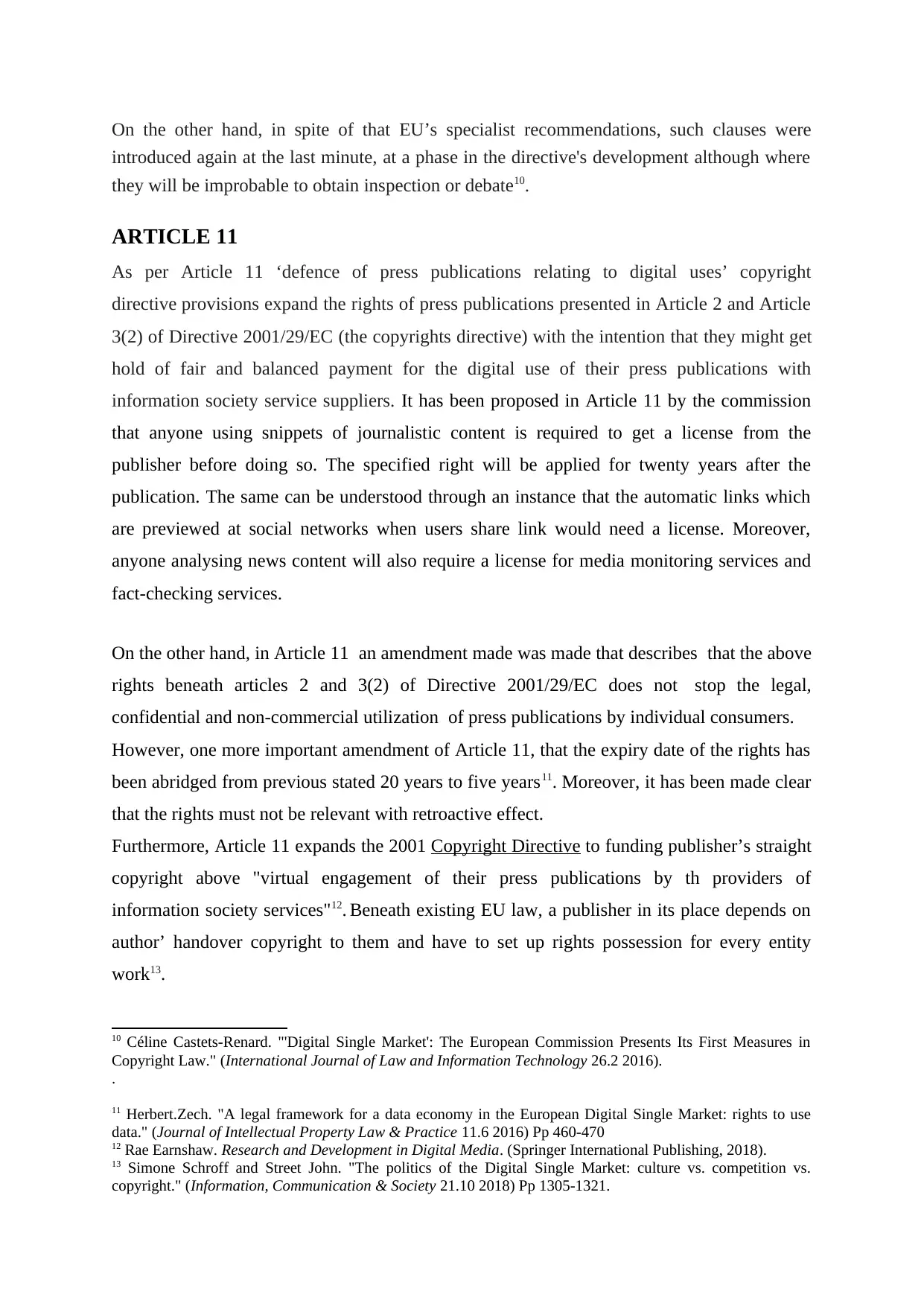
On the other hand, in spite of that EU’s specialist recommendations, such clauses were
introduced again at the last minute, at a phase in the directive's development although where
they will be improbable to obtain inspection or debate10.
ARTICLE 11
As per Article 11 ‘defence of press publications relating to digital uses’ copyright
directive provisions expand the rights of press publications presented in Article 2 and Article
3(2) of Directive 2001/29/EC (the copyrights directive) with the intention that they might get
hold of fair and balanced payment for the digital use of their press publications with
information society service suppliers. It has been proposed in Article 11 by the commission
that anyone using snippets of journalistic content is required to get a license from the
publisher before doing so. The specified right will be applied for twenty years after the
publication. The same can be understood through an instance that the automatic links which
are previewed at social networks when users share link would need a license. Moreover,
anyone analysing news content will also require a license for media monitoring services and
fact-checking services.
On the other hand, in Article 11 an amendment made was made that describes that the above
rights beneath articles 2 and 3(2) of Directive 2001/29/EC does not stop the legal,
confidential and non-commercial utilization of press publications by individual consumers.
However, one more important amendment of Article 11, that the expiry date of the rights has
been abridged from previous stated 20 years to five years11. Moreover, it has been made clear
that the rights must not be relevant with retroactive effect.
Furthermore, Article 11 expands the 2001 Copyright Directive to funding publisher’s straight
copyright above "virtual engagement of their press publications by th providers of
information society services"12. Beneath existing EU law, a publisher in its place depends on
author’ handover copyright to them and have to set up rights possession for every entity
work13.
10 Céline Castets-Renard. "'Digital Single Market': The European Commission Presents Its First Measures in
Copyright Law." (International Journal of Law and Information Technology 26.2 2016).
.
11 Herbert.Zech. "A legal framework for a data economy in the European Digital Single Market: rights to use
data." (Journal of Intellectual Property Law & Practice 11.6 2016) Pp 460-470
12 Rae Earnshaw. Research and Development in Digital Media. (Springer International Publishing, 2018).
13 Simone Schroff and Street John. "The politics of the Digital Single Market: culture vs. competition vs.
copyright." (Information, Communication & Society 21.10 2018) Pp 1305-1321.
introduced again at the last minute, at a phase in the directive's development although where
they will be improbable to obtain inspection or debate10.
ARTICLE 11
As per Article 11 ‘defence of press publications relating to digital uses’ copyright
directive provisions expand the rights of press publications presented in Article 2 and Article
3(2) of Directive 2001/29/EC (the copyrights directive) with the intention that they might get
hold of fair and balanced payment for the digital use of their press publications with
information society service suppliers. It has been proposed in Article 11 by the commission
that anyone using snippets of journalistic content is required to get a license from the
publisher before doing so. The specified right will be applied for twenty years after the
publication. The same can be understood through an instance that the automatic links which
are previewed at social networks when users share link would need a license. Moreover,
anyone analysing news content will also require a license for media monitoring services and
fact-checking services.
On the other hand, in Article 11 an amendment made was made that describes that the above
rights beneath articles 2 and 3(2) of Directive 2001/29/EC does not stop the legal,
confidential and non-commercial utilization of press publications by individual consumers.
However, one more important amendment of Article 11, that the expiry date of the rights has
been abridged from previous stated 20 years to five years11. Moreover, it has been made clear
that the rights must not be relevant with retroactive effect.
Furthermore, Article 11 expands the 2001 Copyright Directive to funding publisher’s straight
copyright above "virtual engagement of their press publications by th providers of
information society services"12. Beneath existing EU law, a publisher in its place depends on
author’ handover copyright to them and have to set up rights possession for every entity
work13.
10 Céline Castets-Renard. "'Digital Single Market': The European Commission Presents Its First Measures in
Copyright Law." (International Journal of Law and Information Technology 26.2 2016).
.
11 Herbert.Zech. "A legal framework for a data economy in the European Digital Single Market: rights to use
data." (Journal of Intellectual Property Law & Practice 11.6 2016) Pp 460-470
12 Rae Earnshaw. Research and Development in Digital Media. (Springer International Publishing, 2018).
13 Simone Schroff and Street John. "The politics of the Digital Single Market: culture vs. competition vs.
copyright." (Information, Communication & Society 21.10 2018) Pp 1305-1321.
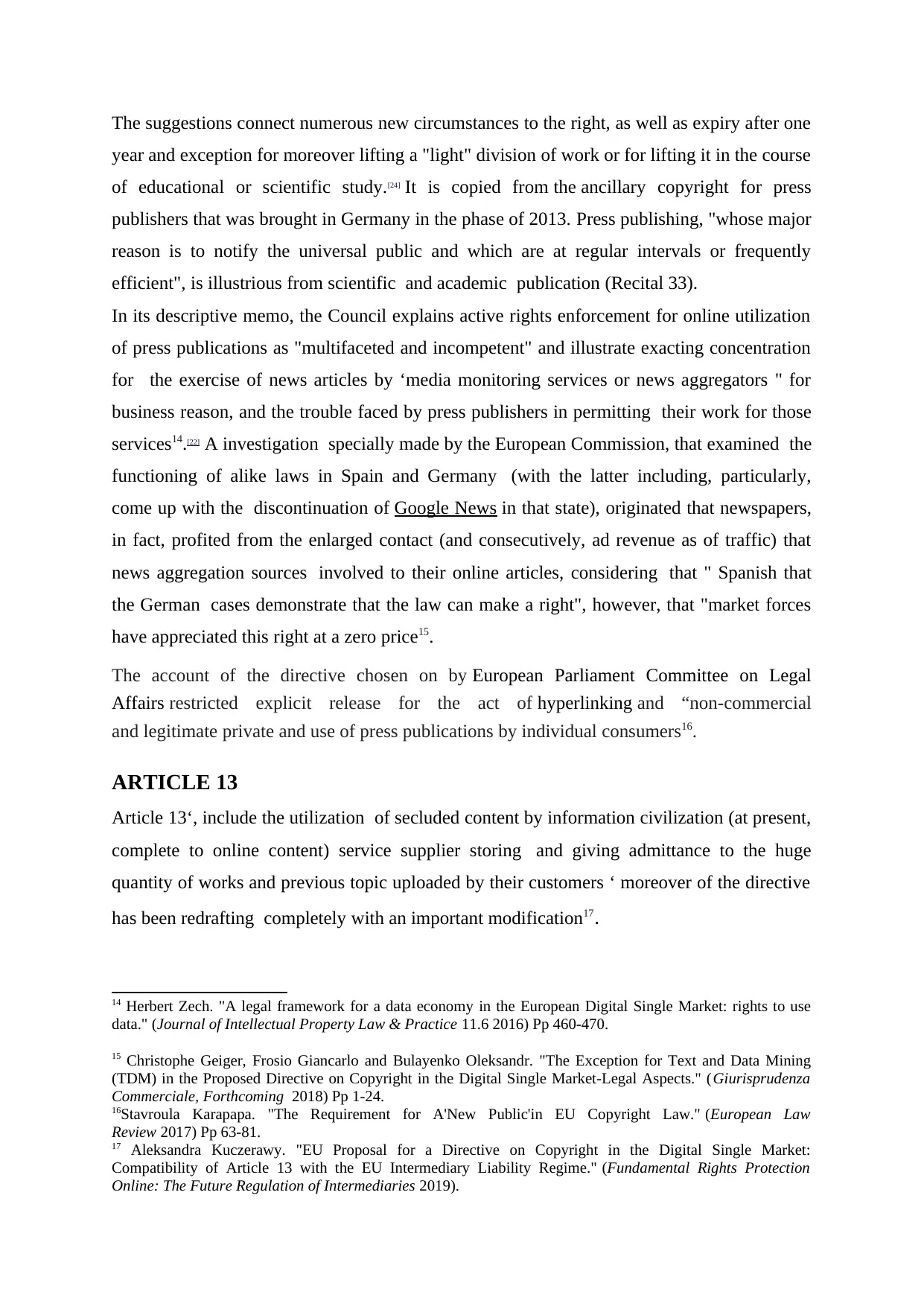
The suggestions connect numerous new circumstances to the right, as well as expiry after one
year and exception for moreover lifting a "light" division of work or for lifting it in the course
of educational or scientific study.[24] It is copied from the ancillary copyright for press
publishers that was brought in Germany in the phase of 2013. Press publishing, "whose major
reason is to notify the universal public and which are at regular intervals or frequently
efficient", is illustrious from scientific and academic publication (Recital 33).
In its descriptive memo, the Council explains active rights enforcement for online utilization
of press publications as "multifaceted and incompetent" and illustrate exacting concentration
for the exercise of news articles by ‘media monitoring services or news aggregators " for
business reason, and the trouble faced by press publishers in permitting their work for those
services14.[22] A investigation specially made by the European Commission, that examined the
functioning of alike laws in Spain and Germany (with the latter including, particularly,
come up with the discontinuation of Google News in that state), originated that newspapers,
in fact, profited from the enlarged contact (and consecutively, ad revenue as of traffic) that
news aggregation sources involved to their online articles, considering that " Spanish that
the German cases demonstrate that the law can make a right", however, that "market forces
have appreciated this right at a zero price15.
The account of the directive chosen on by European Parliament Committee on Legal
Affairs restricted explicit release for the act of hyperlinking and “non-commercial
and legitimate private and use of press publications by individual consumers16.
ARTICLE 13
Article 13‘, include the utilization of secluded content by information civilization (at present,
complete to online content) service supplier storing and giving admittance to the huge
quantity of works and previous topic uploaded by their customers ‘ moreover of the directive
has been redrafting completely with an important modification17.
14 Herbert Zech. "A legal framework for a data economy in the European Digital Single Market: rights to use
data." (Journal of Intellectual Property Law & Practice 11.6 2016) Pp 460-470.
15 Christophe Geiger, Frosio Giancarlo and Bulayenko Oleksandr. "The Exception for Text and Data Mining
(TDM) in the Proposed Directive on Copyright in the Digital Single Market-Legal Aspects." (Giurisprudenza
Commerciale, Forthcoming 2018) Pp 1-24.
16Stavroula Karapapa. "The Requirement for A'New Public'in EU Copyright Law." (European Law
Review 2017) Pp 63-81.
17 Aleksandra Kuczerawy. "EU Proposal for a Directive on Copyright in the Digital Single Market:
Compatibility of Article 13 with the EU Intermediary Liability Regime." (Fundamental Rights Protection
Online: The Future Regulation of Intermediaries 2019).
year and exception for moreover lifting a "light" division of work or for lifting it in the course
of educational or scientific study.[24] It is copied from the ancillary copyright for press
publishers that was brought in Germany in the phase of 2013. Press publishing, "whose major
reason is to notify the universal public and which are at regular intervals or frequently
efficient", is illustrious from scientific and academic publication (Recital 33).
In its descriptive memo, the Council explains active rights enforcement for online utilization
of press publications as "multifaceted and incompetent" and illustrate exacting concentration
for the exercise of news articles by ‘media monitoring services or news aggregators " for
business reason, and the trouble faced by press publishers in permitting their work for those
services14.[22] A investigation specially made by the European Commission, that examined the
functioning of alike laws in Spain and Germany (with the latter including, particularly,
come up with the discontinuation of Google News in that state), originated that newspapers,
in fact, profited from the enlarged contact (and consecutively, ad revenue as of traffic) that
news aggregation sources involved to their online articles, considering that " Spanish that
the German cases demonstrate that the law can make a right", however, that "market forces
have appreciated this right at a zero price15.
The account of the directive chosen on by European Parliament Committee on Legal
Affairs restricted explicit release for the act of hyperlinking and “non-commercial
and legitimate private and use of press publications by individual consumers16.
ARTICLE 13
Article 13‘, include the utilization of secluded content by information civilization (at present,
complete to online content) service supplier storing and giving admittance to the huge
quantity of works and previous topic uploaded by their customers ‘ moreover of the directive
has been redrafting completely with an important modification17.
14 Herbert Zech. "A legal framework for a data economy in the European Digital Single Market: rights to use
data." (Journal of Intellectual Property Law & Practice 11.6 2016) Pp 460-470.
15 Christophe Geiger, Frosio Giancarlo and Bulayenko Oleksandr. "The Exception for Text and Data Mining
(TDM) in the Proposed Directive on Copyright in the Digital Single Market-Legal Aspects." (Giurisprudenza
Commerciale, Forthcoming 2018) Pp 1-24.
16Stavroula Karapapa. "The Requirement for A'New Public'in EU Copyright Law." (European Law
Review 2017) Pp 63-81.
17 Aleksandra Kuczerawy. "EU Proposal for a Directive on Copyright in the Digital Single Market:
Compatibility of Article 13 with the EU Intermediary Liability Regime." (Fundamental Rights Protection
Online: The Future Regulation of Intermediaries 2019).
⊘ This is a preview!⊘
Do you want full access?
Subscribe today to unlock all pages.

Trusted by 1+ million students worldwide
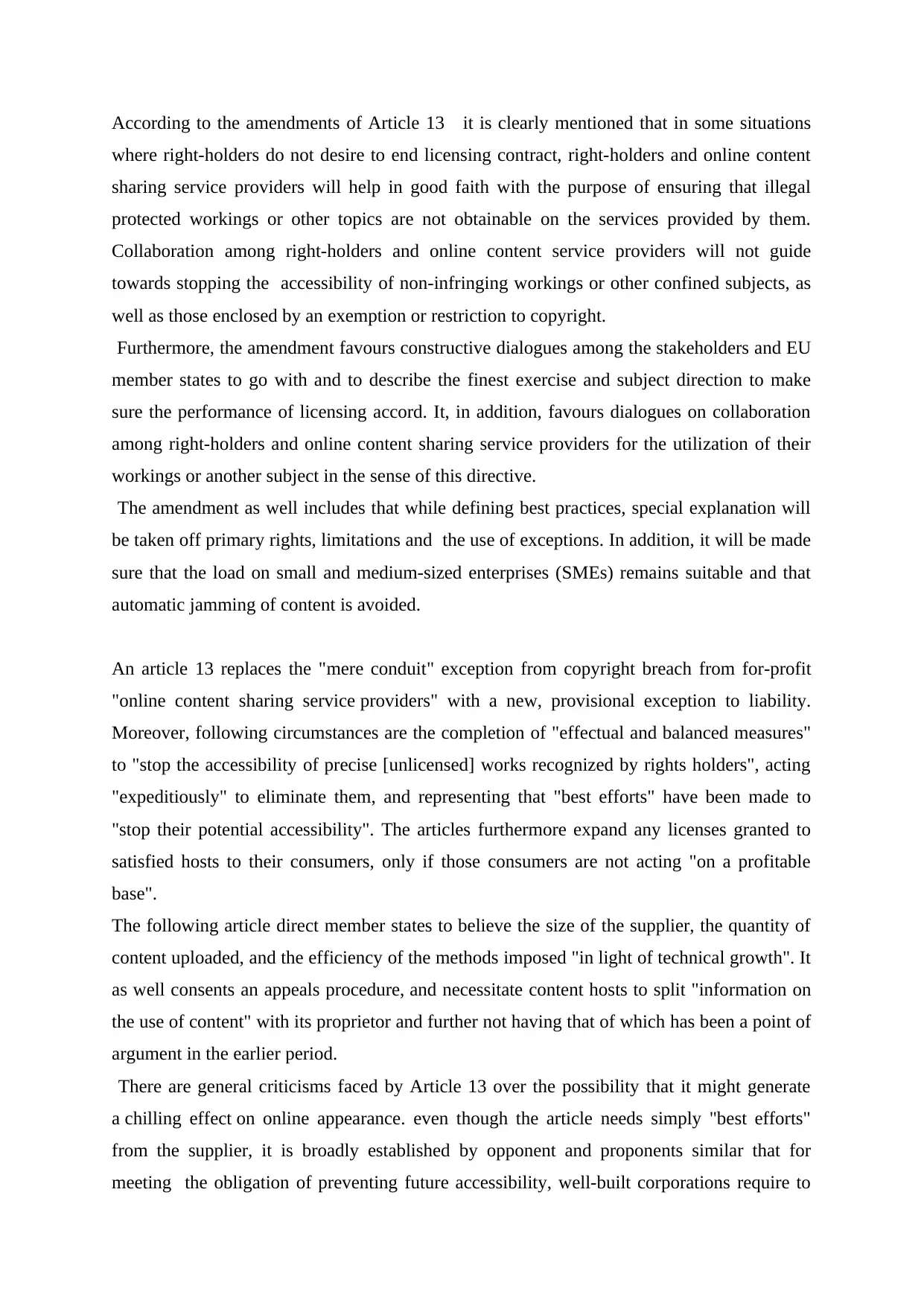
According to the amendments of Article 13 it is clearly mentioned that in some situations
where right-holders do not desire to end licensing contract, right-holders and online content
sharing service providers will help in good faith with the purpose of ensuring that illegal
protected workings or other topics are not obtainable on the services provided by them.
Collaboration among right-holders and online content service providers will not guide
towards stopping the accessibility of non-infringing workings or other confined subjects, as
well as those enclosed by an exemption or restriction to copyright.
Furthermore, the amendment favours constructive dialogues among the stakeholders and EU
member states to go with and to describe the finest exercise and subject direction to make
sure the performance of licensing accord. It, in addition, favours dialogues on collaboration
among right-holders and online content sharing service providers for the utilization of their
workings or another subject in the sense of this directive.
The amendment as well includes that while defining best practices, special explanation will
be taken off primary rights, limitations and the use of exceptions. In addition, it will be made
sure that the load on small and medium-sized enterprises (SMEs) remains suitable and that
automatic jamming of content is avoided.
An article 13 replaces the "mere conduit" exception from copyright breach from for-profit
"online content sharing service providers" with a new, provisional exception to liability.
Moreover, following circumstances are the completion of "effectual and balanced measures"
to "stop the accessibility of precise [unlicensed] works recognized by rights holders", acting
"expeditiously" to eliminate them, and representing that "best efforts" have been made to
"stop their potential accessibility". The articles furthermore expand any licenses granted to
satisfied hosts to their consumers, only if those consumers are not acting "on a profitable
base".
The following article direct member states to believe the size of the supplier, the quantity of
content uploaded, and the efficiency of the methods imposed "in light of technical growth". It
as well consents an appeals procedure, and necessitate content hosts to split "information on
the use of content" with its proprietor and further not having that of which has been a point of
argument in the earlier period.
There are general criticisms faced by Article 13 over the possibility that it might generate
a chilling effect on online appearance. even though the article needs simply "best efforts"
from the supplier, it is broadly established by opponent and proponents similar that for
meeting the obligation of preventing future accessibility, well-built corporations require to
where right-holders do not desire to end licensing contract, right-holders and online content
sharing service providers will help in good faith with the purpose of ensuring that illegal
protected workings or other topics are not obtainable on the services provided by them.
Collaboration among right-holders and online content service providers will not guide
towards stopping the accessibility of non-infringing workings or other confined subjects, as
well as those enclosed by an exemption or restriction to copyright.
Furthermore, the amendment favours constructive dialogues among the stakeholders and EU
member states to go with and to describe the finest exercise and subject direction to make
sure the performance of licensing accord. It, in addition, favours dialogues on collaboration
among right-holders and online content sharing service providers for the utilization of their
workings or another subject in the sense of this directive.
The amendment as well includes that while defining best practices, special explanation will
be taken off primary rights, limitations and the use of exceptions. In addition, it will be made
sure that the load on small and medium-sized enterprises (SMEs) remains suitable and that
automatic jamming of content is avoided.
An article 13 replaces the "mere conduit" exception from copyright breach from for-profit
"online content sharing service providers" with a new, provisional exception to liability.
Moreover, following circumstances are the completion of "effectual and balanced measures"
to "stop the accessibility of precise [unlicensed] works recognized by rights holders", acting
"expeditiously" to eliminate them, and representing that "best efforts" have been made to
"stop their potential accessibility". The articles furthermore expand any licenses granted to
satisfied hosts to their consumers, only if those consumers are not acting "on a profitable
base".
The following article direct member states to believe the size of the supplier, the quantity of
content uploaded, and the efficiency of the methods imposed "in light of technical growth". It
as well consents an appeals procedure, and necessitate content hosts to split "information on
the use of content" with its proprietor and further not having that of which has been a point of
argument in the earlier period.
There are general criticisms faced by Article 13 over the possibility that it might generate
a chilling effect on online appearance. even though the article needs simply "best efforts"
from the supplier, it is broadly established by opponent and proponents similar that for
meeting the obligation of preventing future accessibility, well-built corporations require to
Paraphrase This Document
Need a fresh take? Get an instant paraphrase of this document with our AI Paraphraser
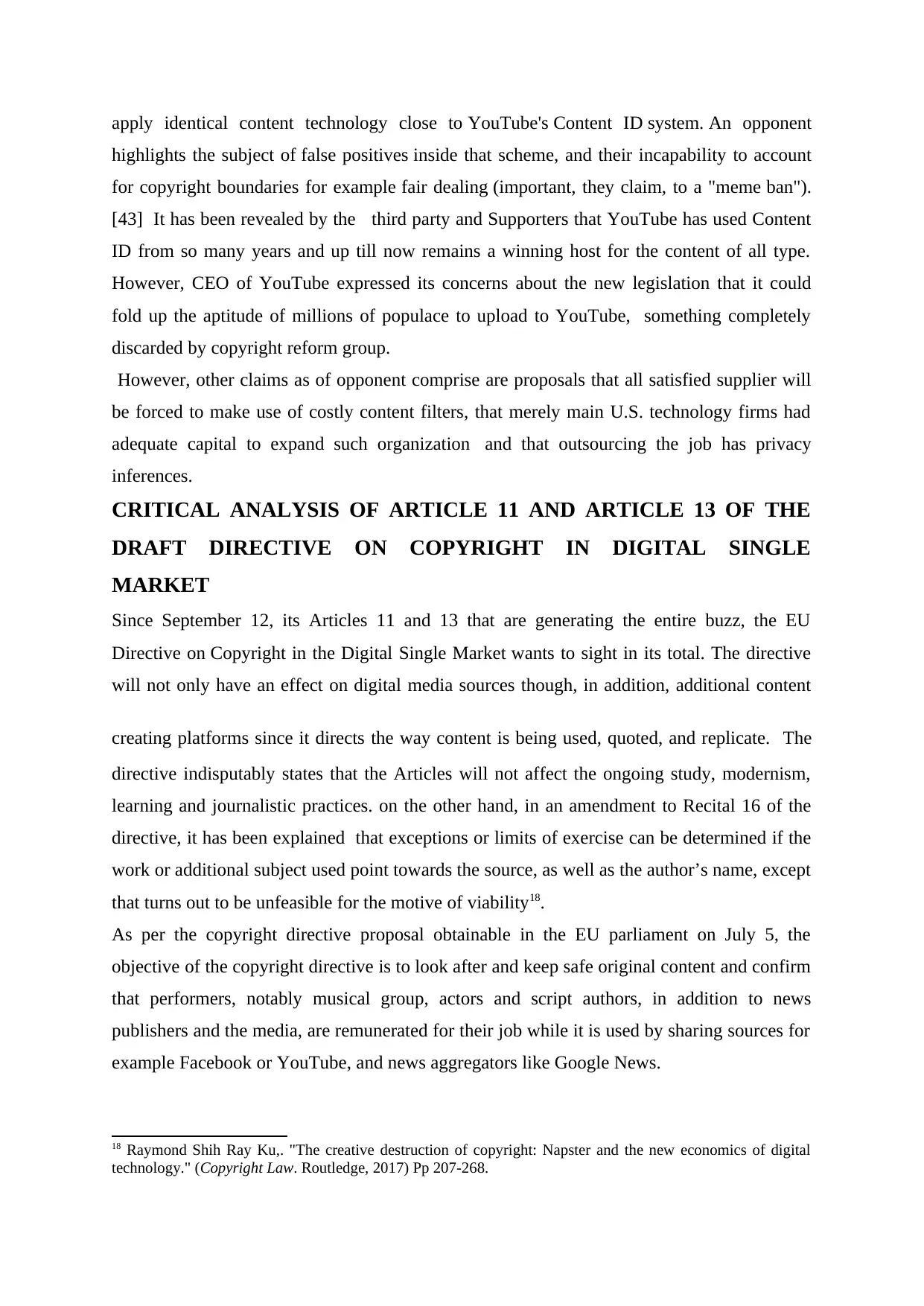
apply identical content technology close to YouTube's Content ID system. An opponent
highlights the subject of false positives inside that scheme, and their incapability to account
for copyright boundaries for example fair dealing (important, they claim, to a "meme ban").
[43] It has been revealed by the third party and Supporters that YouTube has used Content
ID from so many years and up till now remains a winning host for the content of all type.
However, CEO of YouTube expressed its concerns about the new legislation that it could
fold up the aptitude of millions of populace to upload to YouTube, something completely
discarded by copyright reform group.
However, other claims as of opponent comprise are proposals that all satisfied supplier will
be forced to make use of costly content filters, that merely main U.S. technology firms had
adequate capital to expand such organization and that outsourcing the job has privacy
inferences.
CRITICAL ANALYSIS OF ARTICLE 11 AND ARTICLE 13 OF THE
DRAFT DIRECTIVE ON COPYRIGHT IN DIGITAL SINGLE
MARKET
Since September 12, its Articles 11 and 13 that are generating the entire buzz, the EU
Directive on Copyright in the Digital Single Market wants to sight in its total. The directive
will not only have an effect on digital media sources though, in addition, additional content
creating platforms since it directs the way content is being used, quoted, and replicate. The
directive indisputably states that the Articles will not affect the ongoing study, modernism,
learning and journalistic practices. on the other hand, in an amendment to Recital 16 of the
directive, it has been explained that exceptions or limits of exercise can be determined if the
work or additional subject used point towards the source, as well as the author’s name, except
that turns out to be unfeasible for the motive of viability18.
As per the copyright directive proposal obtainable in the EU parliament on July 5, the
objective of the copyright directive is to look after and keep safe original content and confirm
that performers, notably musical group, actors and script authors, in addition to news
publishers and the media, are remunerated for their job while it is used by sharing sources for
example Facebook or YouTube, and news aggregators like Google News.
18 Raymond Shih Ray Ku,. "The creative destruction of copyright: Napster and the new economics of digital
technology." (Copyright Law. Routledge, 2017) Pp 207-268.
highlights the subject of false positives inside that scheme, and their incapability to account
for copyright boundaries for example fair dealing (important, they claim, to a "meme ban").
[43] It has been revealed by the third party and Supporters that YouTube has used Content
ID from so many years and up till now remains a winning host for the content of all type.
However, CEO of YouTube expressed its concerns about the new legislation that it could
fold up the aptitude of millions of populace to upload to YouTube, something completely
discarded by copyright reform group.
However, other claims as of opponent comprise are proposals that all satisfied supplier will
be forced to make use of costly content filters, that merely main U.S. technology firms had
adequate capital to expand such organization and that outsourcing the job has privacy
inferences.
CRITICAL ANALYSIS OF ARTICLE 11 AND ARTICLE 13 OF THE
DRAFT DIRECTIVE ON COPYRIGHT IN DIGITAL SINGLE
MARKET
Since September 12, its Articles 11 and 13 that are generating the entire buzz, the EU
Directive on Copyright in the Digital Single Market wants to sight in its total. The directive
will not only have an effect on digital media sources though, in addition, additional content
creating platforms since it directs the way content is being used, quoted, and replicate. The
directive indisputably states that the Articles will not affect the ongoing study, modernism,
learning and journalistic practices. on the other hand, in an amendment to Recital 16 of the
directive, it has been explained that exceptions or limits of exercise can be determined if the
work or additional subject used point towards the source, as well as the author’s name, except
that turns out to be unfeasible for the motive of viability18.
As per the copyright directive proposal obtainable in the EU parliament on July 5, the
objective of the copyright directive is to look after and keep safe original content and confirm
that performers, notably musical group, actors and script authors, in addition to news
publishers and the media, are remunerated for their job while it is used by sharing sources for
example Facebook or YouTube, and news aggregators like Google News.
18 Raymond Shih Ray Ku,. "The creative destruction of copyright: Napster and the new economics of digital
technology." (Copyright Law. Routledge, 2017) Pp 207-268.
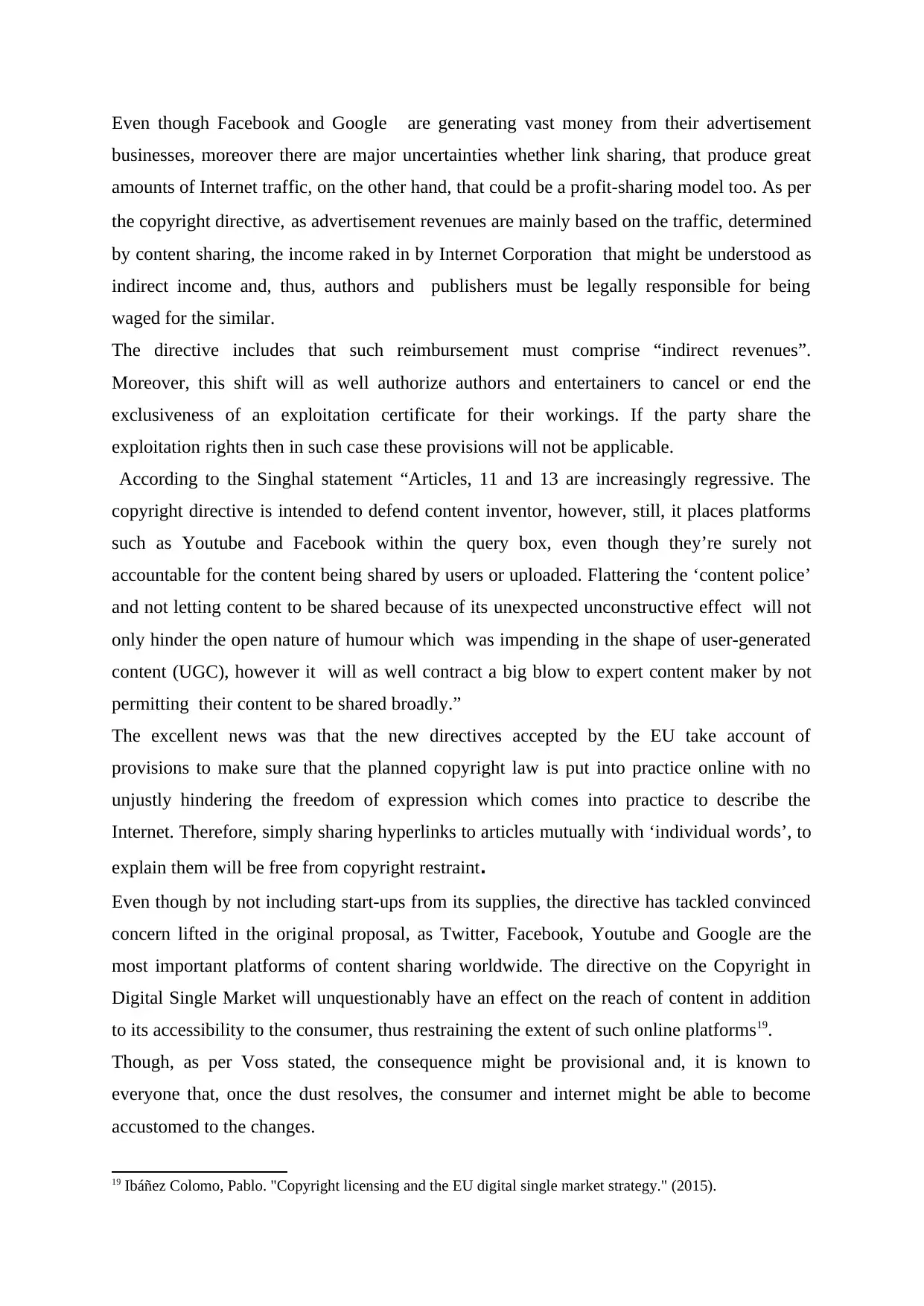
Even though Facebook and Google are generating vast money from their advertisement
businesses, moreover there are major uncertainties whether link sharing, that produce great
amounts of Internet traffic, on the other hand, that could be a profit-sharing model too. As per
the copyright directive, as advertisement revenues are mainly based on the traffic, determined
by content sharing, the income raked in by Internet Corporation that might be understood as
indirect income and, thus, authors and publishers must be legally responsible for being
waged for the similar.
The directive includes that such reimbursement must comprise “indirect revenues”.
Moreover, this shift will as well authorize authors and entertainers to cancel or end the
exclusiveness of an exploitation certificate for their workings. If the party share the
exploitation rights then in such case these provisions will not be applicable.
According to the Singhal statement “Articles, 11 and 13 are increasingly regressive. The
copyright directive is intended to defend content inventor, however, still, it places platforms
such as Youtube and Facebook within the query box, even though they’re surely not
accountable for the content being shared by users or uploaded. Flattering the ‘content police’
and not letting content to be shared because of its unexpected unconstructive effect will not
only hinder the open nature of humour which was impending in the shape of user-generated
content (UGC), however it will as well contract a big blow to expert content maker by not
permitting their content to be shared broadly.”
The excellent news was that the new directives accepted by the EU take account of
provisions to make sure that the planned copyright law is put into practice online with no
unjustly hindering the freedom of expression which comes into practice to describe the
Internet. Therefore, simply sharing hyperlinks to articles mutually with ‘individual words’, to
explain them will be free from copyright restraint.
Even though by not including start-ups from its supplies, the directive has tackled convinced
concern lifted in the original proposal, as Twitter, Facebook, Youtube and Google are the
most important platforms of content sharing worldwide. The directive on the Copyright in
Digital Single Market will unquestionably have an effect on the reach of content in addition
to its accessibility to the consumer, thus restraining the extent of such online platforms19.
Though, as per Voss stated, the consequence might be provisional and, it is known to
everyone that, once the dust resolves, the consumer and internet might be able to become
accustomed to the changes.
19 Ibáñez Colomo, Pablo. "Copyright licensing and the EU digital single market strategy." (2015).
businesses, moreover there are major uncertainties whether link sharing, that produce great
amounts of Internet traffic, on the other hand, that could be a profit-sharing model too. As per
the copyright directive, as advertisement revenues are mainly based on the traffic, determined
by content sharing, the income raked in by Internet Corporation that might be understood as
indirect income and, thus, authors and publishers must be legally responsible for being
waged for the similar.
The directive includes that such reimbursement must comprise “indirect revenues”.
Moreover, this shift will as well authorize authors and entertainers to cancel or end the
exclusiveness of an exploitation certificate for their workings. If the party share the
exploitation rights then in such case these provisions will not be applicable.
According to the Singhal statement “Articles, 11 and 13 are increasingly regressive. The
copyright directive is intended to defend content inventor, however, still, it places platforms
such as Youtube and Facebook within the query box, even though they’re surely not
accountable for the content being shared by users or uploaded. Flattering the ‘content police’
and not letting content to be shared because of its unexpected unconstructive effect will not
only hinder the open nature of humour which was impending in the shape of user-generated
content (UGC), however it will as well contract a big blow to expert content maker by not
permitting their content to be shared broadly.”
The excellent news was that the new directives accepted by the EU take account of
provisions to make sure that the planned copyright law is put into practice online with no
unjustly hindering the freedom of expression which comes into practice to describe the
Internet. Therefore, simply sharing hyperlinks to articles mutually with ‘individual words’, to
explain them will be free from copyright restraint.
Even though by not including start-ups from its supplies, the directive has tackled convinced
concern lifted in the original proposal, as Twitter, Facebook, Youtube and Google are the
most important platforms of content sharing worldwide. The directive on the Copyright in
Digital Single Market will unquestionably have an effect on the reach of content in addition
to its accessibility to the consumer, thus restraining the extent of such online platforms19.
Though, as per Voss stated, the consequence might be provisional and, it is known to
everyone that, once the dust resolves, the consumer and internet might be able to become
accustomed to the changes.
19 Ibáñez Colomo, Pablo. "Copyright licensing and the EU digital single market strategy." (2015).
⊘ This is a preview!⊘
Do you want full access?
Subscribe today to unlock all pages.

Trusted by 1+ million students worldwide
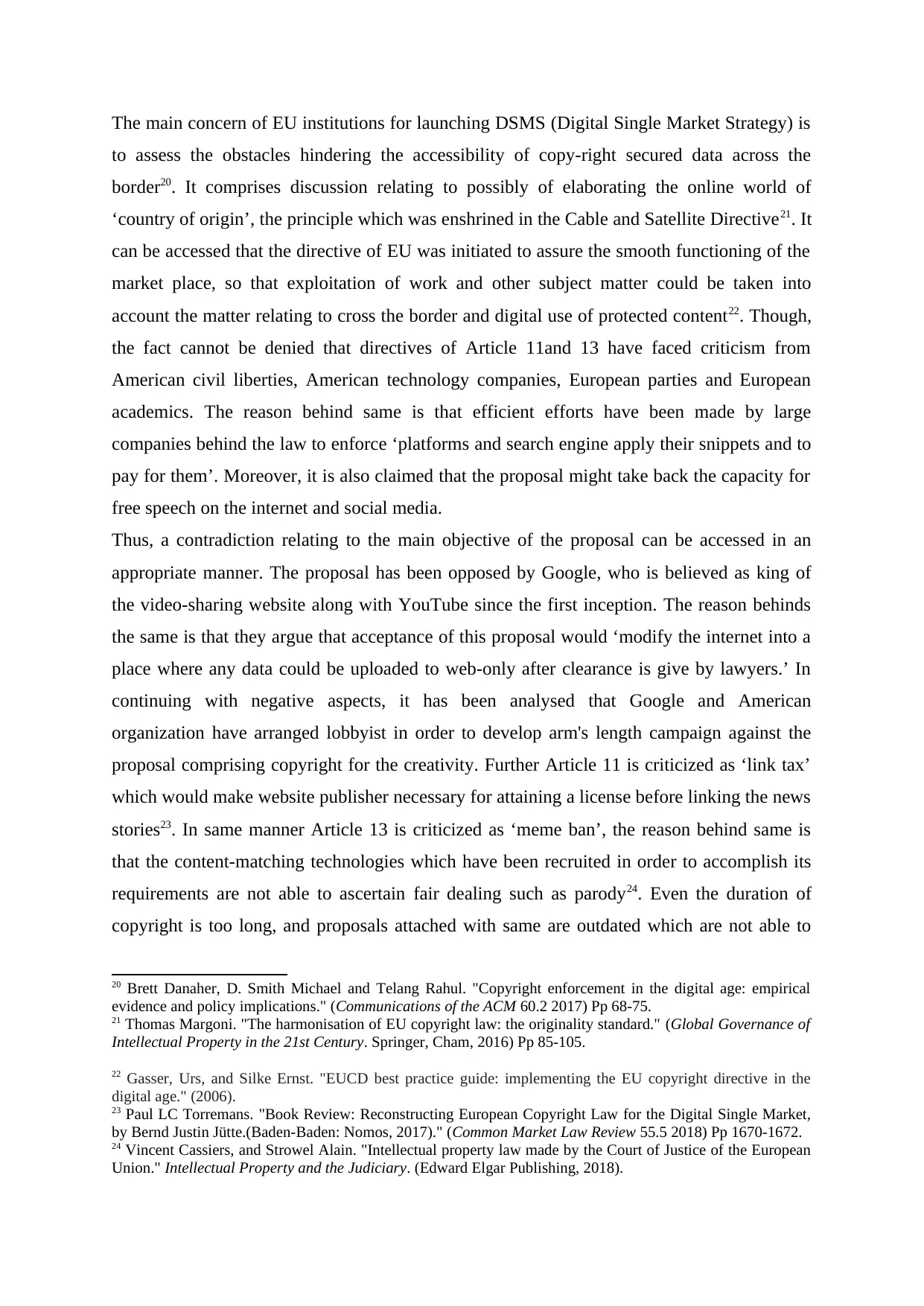
The main concern of EU institutions for launching DSMS (Digital Single Market Strategy) is
to assess the obstacles hindering the accessibility of copy-right secured data across the
border20. It comprises discussion relating to possibly of elaborating the online world of
‘country of origin’, the principle which was enshrined in the Cable and Satellite Directive21. It
can be accessed that the directive of EU was initiated to assure the smooth functioning of the
market place, so that exploitation of work and other subject matter could be taken into
account the matter relating to cross the border and digital use of protected content22. Though,
the fact cannot be denied that directives of Article 11and 13 have faced criticism from
American civil liberties, American technology companies, European parties and European
academics. The reason behind same is that efficient efforts have been made by large
companies behind the law to enforce ‘platforms and search engine apply their snippets and to
pay for them’. Moreover, it is also claimed that the proposal might take back the capacity for
free speech on the internet and social media.
Thus, a contradiction relating to the main objective of the proposal can be accessed in an
appropriate manner. The proposal has been opposed by Google, who is believed as king of
the video-sharing website along with YouTube since the first inception. The reason behinds
the same is that they argue that acceptance of this proposal would ‘modify the internet into a
place where any data could be uploaded to web-only after clearance is give by lawyers.’ In
continuing with negative aspects, it has been analysed that Google and American
organization have arranged lobbyist in order to develop arm's length campaign against the
proposal comprising copyright for the creativity. Further Article 11 is criticized as ‘link tax’
which would make website publisher necessary for attaining a license before linking the news
stories23. In same manner Article 13 is criticized as ‘meme ban’, the reason behind same is
that the content-matching technologies which have been recruited in order to accomplish its
requirements are not able to ascertain fair dealing such as parody24. Even the duration of
copyright is too long, and proposals attached with same are outdated which are not able to
20 Brett Danaher, D. Smith Michael and Telang Rahul. "Copyright enforcement in the digital age: empirical
evidence and policy implications." (Communications of the ACM 60.2 2017) Pp 68-75.
21 Thomas Margoni. "The harmonisation of EU copyright law: the originality standard." (Global Governance of
Intellectual Property in the 21st Century. Springer, Cham, 2016) Pp 85-105.
22 Gasser, Urs, and Silke Ernst. "EUCD best practice guide: implementing the EU copyright directive in the
digital age." (2006).
23 Paul LC Torremans. "Book Review: Reconstructing European Copyright Law for the Digital Single Market,
by Bernd Justin Jütte.(Baden-Baden: Nomos, 2017)." (Common Market Law Review 55.5 2018) Pp 1670-1672.
24 Vincent Cassiers, and Strowel Alain. "Intellectual property law made by the Court of Justice of the European
Union." Intellectual Property and the Judiciary. (Edward Elgar Publishing, 2018).
to assess the obstacles hindering the accessibility of copy-right secured data across the
border20. It comprises discussion relating to possibly of elaborating the online world of
‘country of origin’, the principle which was enshrined in the Cable and Satellite Directive21. It
can be accessed that the directive of EU was initiated to assure the smooth functioning of the
market place, so that exploitation of work and other subject matter could be taken into
account the matter relating to cross the border and digital use of protected content22. Though,
the fact cannot be denied that directives of Article 11and 13 have faced criticism from
American civil liberties, American technology companies, European parties and European
academics. The reason behind same is that efficient efforts have been made by large
companies behind the law to enforce ‘platforms and search engine apply their snippets and to
pay for them’. Moreover, it is also claimed that the proposal might take back the capacity for
free speech on the internet and social media.
Thus, a contradiction relating to the main objective of the proposal can be accessed in an
appropriate manner. The proposal has been opposed by Google, who is believed as king of
the video-sharing website along with YouTube since the first inception. The reason behinds
the same is that they argue that acceptance of this proposal would ‘modify the internet into a
place where any data could be uploaded to web-only after clearance is give by lawyers.’ In
continuing with negative aspects, it has been analysed that Google and American
organization have arranged lobbyist in order to develop arm's length campaign against the
proposal comprising copyright for the creativity. Further Article 11 is criticized as ‘link tax’
which would make website publisher necessary for attaining a license before linking the news
stories23. In same manner Article 13 is criticized as ‘meme ban’, the reason behind same is
that the content-matching technologies which have been recruited in order to accomplish its
requirements are not able to ascertain fair dealing such as parody24. Even the duration of
copyright is too long, and proposals attached with same are outdated which are not able to
20 Brett Danaher, D. Smith Michael and Telang Rahul. "Copyright enforcement in the digital age: empirical
evidence and policy implications." (Communications of the ACM 60.2 2017) Pp 68-75.
21 Thomas Margoni. "The harmonisation of EU copyright law: the originality standard." (Global Governance of
Intellectual Property in the 21st Century. Springer, Cham, 2016) Pp 85-105.
22 Gasser, Urs, and Silke Ernst. "EUCD best practice guide: implementing the EU copyright directive in the
digital age." (2006).
23 Paul LC Torremans. "Book Review: Reconstructing European Copyright Law for the Digital Single Market,
by Bernd Justin Jütte.(Baden-Baden: Nomos, 2017)." (Common Market Law Review 55.5 2018) Pp 1670-1672.
24 Vincent Cassiers, and Strowel Alain. "Intellectual property law made by the Court of Justice of the European
Union." Intellectual Property and the Judiciary. (Edward Elgar Publishing, 2018).
Paraphrase This Document
Need a fresh take? Get an instant paraphrase of this document with our AI Paraphraser
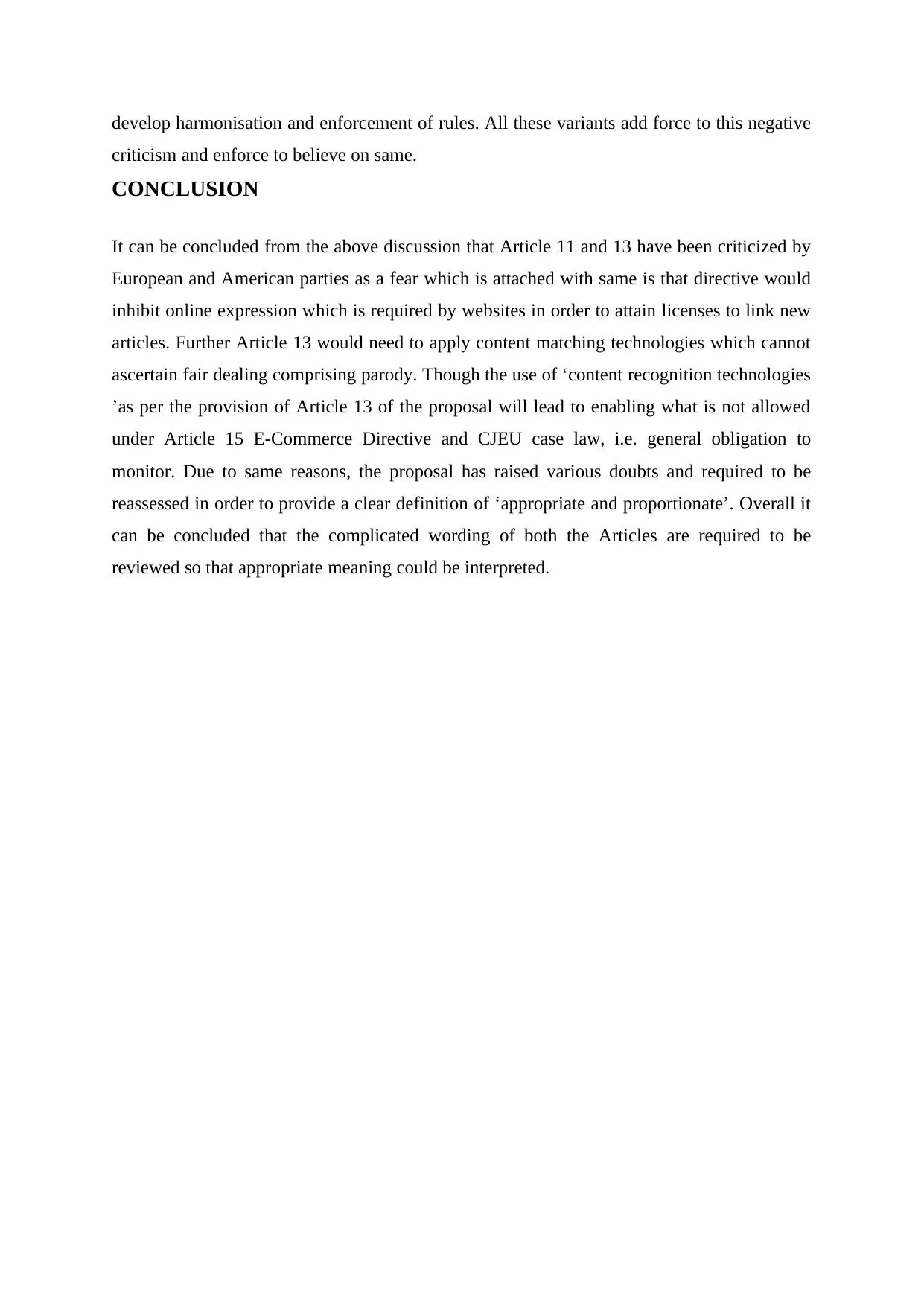
develop harmonisation and enforcement of rules. All these variants add force to this negative
criticism and enforce to believe on same.
CONCLUSION
It can be concluded from the above discussion that Article 11 and 13 have been criticized by
European and American parties as a fear which is attached with same is that directive would
inhibit online expression which is required by websites in order to attain licenses to link new
articles. Further Article 13 would need to apply content matching technologies which cannot
ascertain fair dealing comprising parody. Though the use of ‘content recognition technologies
’as per the provision of Article 13 of the proposal will lead to enabling what is not allowed
under Article 15 E-Commerce Directive and CJEU case law, i.e. general obligation to
monitor. Due to same reasons, the proposal has raised various doubts and required to be
reassessed in order to provide a clear definition of ‘appropriate and proportionate’. Overall it
can be concluded that the complicated wording of both the Articles are required to be
reviewed so that appropriate meaning could be interpreted.
criticism and enforce to believe on same.
CONCLUSION
It can be concluded from the above discussion that Article 11 and 13 have been criticized by
European and American parties as a fear which is attached with same is that directive would
inhibit online expression which is required by websites in order to attain licenses to link new
articles. Further Article 13 would need to apply content matching technologies which cannot
ascertain fair dealing comprising parody. Though the use of ‘content recognition technologies
’as per the provision of Article 13 of the proposal will lead to enabling what is not allowed
under Article 15 E-Commerce Directive and CJEU case law, i.e. general obligation to
monitor. Due to same reasons, the proposal has raised various doubts and required to be
reassessed in order to provide a clear definition of ‘appropriate and proportionate’. Overall it
can be concluded that the complicated wording of both the Articles are required to be
reviewed so that appropriate meaning could be interpreted.
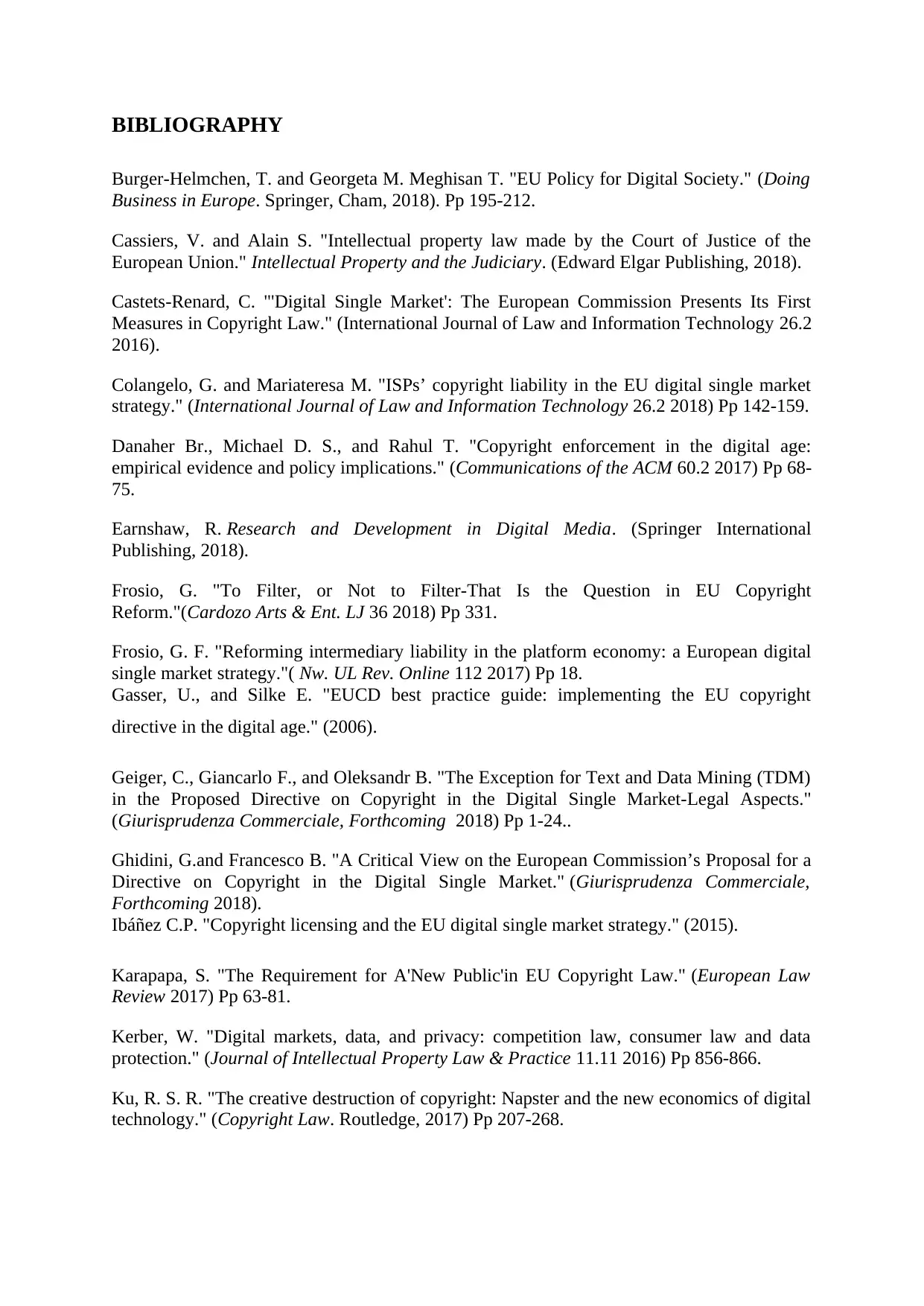
BIBLIOGRAPHY
Burger-Helmchen, T. and Georgeta M. Meghisan T. "EU Policy for Digital Society." (Doing
Business in Europe. Springer, Cham, 2018). Pp 195-212.
Cassiers, V. and Alain S. "Intellectual property law made by the Court of Justice of the
European Union." Intellectual Property and the Judiciary. (Edward Elgar Publishing, 2018).
Castets-Renard, C. "'Digital Single Market': The European Commission Presents Its First
Measures in Copyright Law." (International Journal of Law and Information Technology 26.2
2016).
Colangelo, G. and Mariateresa M. "ISPs’ copyright liability in the EU digital single market
strategy." (International Journal of Law and Information Technology 26.2 2018) Pp 142-159.
Danaher Br., Michael D. S., and Rahul T. "Copyright enforcement in the digital age:
empirical evidence and policy implications." (Communications of the ACM 60.2 2017) Pp 68-
75.
Earnshaw, R. Research and Development in Digital Media. (Springer International
Publishing, 2018).
Frosio, G. "To Filter, or Not to Filter-That Is the Question in EU Copyright
Reform."(Cardozo Arts & Ent. LJ 36 2018) Pp 331.
Frosio, G. F. "Reforming intermediary liability in the platform economy: a European digital
single market strategy."( Nw. UL Rev. Online 112 2017) Pp 18.
Gasser, U., and Silke E. "EUCD best practice guide: implementing the EU copyright
directive in the digital age." (2006).
Geiger, C., Giancarlo F., and Oleksandr B. "The Exception for Text and Data Mining (TDM)
in the Proposed Directive on Copyright in the Digital Single Market-Legal Aspects."
(Giurisprudenza Commerciale, Forthcoming 2018) Pp 1-24..
Ghidini, G.and Francesco B. "A Critical View on the European Commission’s Proposal for a
Directive on Copyright in the Digital Single Market." (Giurisprudenza Commerciale,
Forthcoming 2018).
Ibáñez C.P. "Copyright licensing and the EU digital single market strategy." (2015).
Karapapa, S. "The Requirement for A'New Public'in EU Copyright Law." (European Law
Review 2017) Pp 63-81.
Kerber, W. "Digital markets, data, and privacy: competition law, consumer law and data
protection." (Journal of Intellectual Property Law & Practice 11.11 2016) Pp 856-866.
Ku, R. S. R. "The creative destruction of copyright: Napster and the new economics of digital
technology." (Copyright Law. Routledge, 2017) Pp 207-268.
Burger-Helmchen, T. and Georgeta M. Meghisan T. "EU Policy for Digital Society." (Doing
Business in Europe. Springer, Cham, 2018). Pp 195-212.
Cassiers, V. and Alain S. "Intellectual property law made by the Court of Justice of the
European Union." Intellectual Property and the Judiciary. (Edward Elgar Publishing, 2018).
Castets-Renard, C. "'Digital Single Market': The European Commission Presents Its First
Measures in Copyright Law." (International Journal of Law and Information Technology 26.2
2016).
Colangelo, G. and Mariateresa M. "ISPs’ copyright liability in the EU digital single market
strategy." (International Journal of Law and Information Technology 26.2 2018) Pp 142-159.
Danaher Br., Michael D. S., and Rahul T. "Copyright enforcement in the digital age:
empirical evidence and policy implications." (Communications of the ACM 60.2 2017) Pp 68-
75.
Earnshaw, R. Research and Development in Digital Media. (Springer International
Publishing, 2018).
Frosio, G. "To Filter, or Not to Filter-That Is the Question in EU Copyright
Reform."(Cardozo Arts & Ent. LJ 36 2018) Pp 331.
Frosio, G. F. "Reforming intermediary liability in the platform economy: a European digital
single market strategy."( Nw. UL Rev. Online 112 2017) Pp 18.
Gasser, U., and Silke E. "EUCD best practice guide: implementing the EU copyright
directive in the digital age." (2006).
Geiger, C., Giancarlo F., and Oleksandr B. "The Exception for Text and Data Mining (TDM)
in the Proposed Directive on Copyright in the Digital Single Market-Legal Aspects."
(Giurisprudenza Commerciale, Forthcoming 2018) Pp 1-24..
Ghidini, G.and Francesco B. "A Critical View on the European Commission’s Proposal for a
Directive on Copyright in the Digital Single Market." (Giurisprudenza Commerciale,
Forthcoming 2018).
Ibáñez C.P. "Copyright licensing and the EU digital single market strategy." (2015).
Karapapa, S. "The Requirement for A'New Public'in EU Copyright Law." (European Law
Review 2017) Pp 63-81.
Kerber, W. "Digital markets, data, and privacy: competition law, consumer law and data
protection." (Journal of Intellectual Property Law & Practice 11.11 2016) Pp 856-866.
Ku, R. S. R. "The creative destruction of copyright: Napster and the new economics of digital
technology." (Copyright Law. Routledge, 2017) Pp 207-268.
⊘ This is a preview!⊘
Do you want full access?
Subscribe today to unlock all pages.

Trusted by 1+ million students worldwide
1 out of 13
Your All-in-One AI-Powered Toolkit for Academic Success.
+13062052269
info@desklib.com
Available 24*7 on WhatsApp / Email
![[object Object]](/_next/static/media/star-bottom.7253800d.svg)
Unlock your academic potential
Copyright © 2020–2025 A2Z Services. All Rights Reserved. Developed and managed by ZUCOL.

